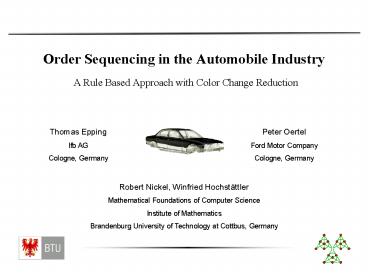Order Sequencing in the Automobile Industry PowerPoint PPT Presentation
Title: Order Sequencing in the Automobile Industry
1
Order Sequencing in the Automobile Industry
- A Rule Based Approach with Color Change Reduction
Thomas Epping Ifb AG Cologne, Germany
Peter Oertel Ford Motor Company Cologne, Germany
Robert Nickel, Winfried Hochstättler Mathematical
Foundations of Computer Science Institute of
Mathematics Brandenburg University of Technology
at Cottbus, Germany
2
Outline
- A Framework for Order Sequencing
- Rules for Order Sequencing
- A Greedy Approach for Sequence Construction
- Order Clustering to Reduce Color Changes
3
A Typical Production Plant
Body Shop
Paint Shop
Assembly Shop
- press, weld, and mount the car body
- enamel the body-in-white
- implement optional components
- For all zones a set of rules must be respected
- Storage systems allow color change reduction by
short term interchanges prior to the paint shop
4
Orders and Commodities
Commodities
- car glass(toned?)
- power steering
- seats(standard / leather / sport)
- air conditioner
- engine (div. types)
- central locking
- sun roof(slide/lift)
Order
5
Manufacturing Errors
- Production process is essentially probabilistic
- Commodities are delayed due to manufacturing
errors - An exact optimization model is not sensible
- Three major goals
- Robustness
- Transparency
- Performance
- Instead of objectives we use rules with priority
to evaluate the result - We model the production process in a
deterministic way
6
Deterministic Routing of Order Positions
- What happens at the split point of zones?
- Zones work with different speed / capacity
- The time an order needs to pass a zone is equal
for parallel zones
parallel zones
non-parallel zone
1
2
3
4
5
6
15
7
Deterministic Routing of Order Positions
- There is more than one split point
It suffices to consider the master sequence and a
set of patterns
(1,2)(1,1)(1,2)(1,1)(1,2)(1,1)
(1,1,2)(2,1,1)(1,1,2)(1,1,1)
8
Manufacturing Errors
- Manufacturing errors could occur during the
production process - Use statistical data to determine the expected
delay of a commodity on a zone
zone z expected delay of c in z 5
order with commodity c
- c will appear later in zones succeeding z
(respecting quotas) - This enables to compute a more realistic order
sequence
9
The Rule Set
- Rules can be applied to each pair (c,z) of
commodity and zone - Any order containing c routed through zone z must
respect this rule - A priority p1,,10 is assigned to each rule
- Achieve a sequence with lexicographically minimal
number of rule breaches
- Spreading Rule Orders with a commodity should be
evenly spread
- Ratio Rule A commodity is allowed in at most x
out of y consecutive sequence positions of a zone
- Banning Rule A commodity is banned from an
interval of a zone
- Clustering Rule A commodity is allowed to occur
in s out of S slots of the master sequence
- Spacing Rule Orders that hold a commodity c
should occur with a minimal distance
- Grouping Rule Orders that hold a commodity c
should occur in groups with minimal and maximal
size, where groups must keep a minimal distance
- Two concurrent strategies for rule evaluation
- Count the number of rule breaches for each
priority(quantity of rule breaches) - Increase a penalty value for a broken
rule(quality of rule breaches) - Clustering rule is considered separately
10
Greedy Master Sequence Construction
- Simplification
- Clustering rules are zone independent
- There is at most one clustering commodity per
order (suitable for color clustering)
- Orders are assigned to slots of the master
sequence
- Compute each slot of the master sequence
separately (Divide Conquer)
- Known approach Goal Chasing (Monden 1983)
- Choose step by step an order which assures an
even resource consumption - Only suitable for spreading
- Modified Goal Chasing approach
- Choose in every step a best order
- with lexicographically minimized rule breach
vector b(b1,, b10) - and minimized penalty (priority-weighted
penalties)
- Fully configurable by the choice of priorities
11
Order Clustering Algorithm
- Let c1,,cu denote all clustering commoditiesand
O(c) the set of all orders containing commodity
c.
- 1. Assign to each clustering commodity its
preferred slots - Other banning rules could imply varying ratio of
a commodity - Spreading commodities must be evenly distributed
over the slots
- Assign each order to a preferred slot
- Consider banning and spreading rules
12
Best Vector Packing into Bins Problem
- Let e1,,er denote all spreading commodities
- For each set O(ci) introduce a vector wi (U is
the set of non-clustering orders)
- Slots contain vectors indexed from 1 to r1
- The last component is reserved to ensure that a
slot is filled completely
- Split these vectors according to the desired
number of slots
- Greedy approach In each step choose a pair of
vector and bin, so that the vector improves on
the bins contents best possible - This yields an assignment of an order o to its
set of preferred slots S(o).
13
Assignment of Orders to Slots
- Given for each order o a set S(o) of preferred
slots - Assign each order to a preferred slot (respect
other banning / spreading rules) - Binary variable xo,s to indicate that o is
assigned to slot s.
- Spreading objective
- Clustering objective
- Slot size constraint
- Banning constraint
- Number of variables can be reduced significantly
14
Results
- Easily configurable
- simple rule definitions
- transparent parameter tuning with priorities
- High performance
- Operates with greedy subroutines and on small
linear programs only - About 3 minutes on 1500 orders and realistic
rules (Sun 450 MHz, 1GB)
- Color batch size increased by 50
- The algorithm is currently used in all automobile
plants of the Ford Motor Company across Europe
15
Thanks for your attention.

